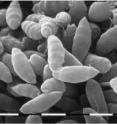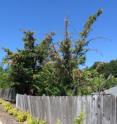Tree-killing pathogen traced back to California
Related images
(click to enlarge)
Genetic detective work by an international group of researchers may have solved a decades-long mystery of the source of a devastating tree-killing fungus that has hit six of the world's seven continents. In a study published Sept. 1 in the peer-reviewed journal Phytopathology, California emerged as the top suspect for the pathogen Seiridium cardinale that is the cause of cypress canker disease.
It was in California's San Joaquin Valley in 1928 that S. cardinale was first identified as the culprit causing the disease. The fungus has made its way since to Europe, Asia, New Zealand, Australia, South America and Africa. In many regions, the pathogen has infected and killed up to 95 percent of native trees in the cypress family, including junipers and some cedars.
"The fungus was likely introduced from California either in the South of France or in Central Italy 60 to 80 years ago, and that introduction resulted in a global pandemic that has devastated the region's iconic Italian cypress trees," said Matteo Garbelotto, adjunct associate professor and cooperative extension specialist in ecosystem sciences at the University of California, Berkeley.
The fungus kills a tree by entering through cracks in its bark, producing toxins that wreak havoc with its flow of sap and choke off its supply of water and nutrients. The disease has left an indelible mark throughout Southern Europe.
"Italian cypress trees are important to the ecosystem, but they are also considered the quintessential trees of the Mediterranean, the ones that dot the Tuscan countryside and that form the landscape of much of Greece, the South of France and Spain," said study lead author Gianni Della Rocca, researcher at the National Research Council in Florence, Italy. "It is difficult to put a price tag on the impact this pathogen has had. It's hard to imagine the Tuscan or Provence landscape without cypresses."
DNA detectives
The relatively sudden appearance and destructiveness of the disease in Europe pointed to an exotic pathogen, but scientists didn't know where it came from. Tracing the origins of the pathogen back to California took some genetic sleuthing by Garbelotto, Della Rocca and their colleagues Catherine Eyre, a UC Berkeley post-doctoral researcher in ecosystem sciences, and Roberto Danti, a researcher at the Italian National Research Council.
The researchers used modern DNA fingerprinting techniques to analyze 96 S. cardinale isolates of diseased tree samples from seven Mediterranean countries, eight California counties, Chile and New Zealand.
S. cardinale is capable of reproducing asexually by creating genetically identical clones of itself, or sexually when a different variant is available for mating.
California emerged as a likely culprit because it hosts populations of the pathogen that are genetically diverse, a strong sign that the pathogen is endemic to the region, the researchers said. The study authors attribute the diversity to the likely sexual reproduction of two genetic variants of the pathogen found in California.
In contrast, the researchers found that one of the two variants of S. cardinale endemic to California is responsible for the epidemic of cypress canker in the Mediterranean, an indication that the fungi thereall descended from a "founder" genotype that made its way to Europe.
The second variant found in California, incidentally, has been linked to the epidemic in countries in the Southern Hemisphere such as New Zealand and Chile.
Just how the pathogen moved from California outward is not yet clear, the researchers said. What they can say with certainty is that humans helped the pathogen along in its journey, since air and sea currents alone could not account for the discovery of identical genotypes thousands of miles apart. The paper reports that strains of the pathogen with identical DNA profiles were found hundreds to thousands of miles apart, an indication that humans are actually moving the pathogen, most likely thorough the trade of infected plants.
Following completion of the study, the researchers looked through historical catalogues of large commercial nurseries in Italy and France and found records of mature Monterey cypress trees for sale during the late 1920s and 1930s, indicating significant imports of the California trees and their seeds at that time.
"It is very likely that the pathogen was introduced during that period," said Danti, who added that interviews the research team conducted with people who worked in the nurseries then suggested that cypress canker disease was becoming a problem by the late 1930s.
The researchers found three progenitor strains of the pathogen only in Tuscany, indicating that the disease was brewing there for several generations before exploding beyond the region's borders.
"It could have easily taken 10 to 20 years from the time of introduction for the first major outbreak to occur," said Garbelotto. "In Italy, the pathogen was first identified in 1951, so it could have arrived decades earlier."
The study authors advocate the genetic screening of plants to stem the spread of the disease, just as plant shipments in and out of California are now tested for the Sudden Oak Death pathogen.
"We can develop tests to screen for the presence of S. cardinale on plants that are traded, and even to test for the presence of strains that are currently not present in Europe or in the Southern Hemisphere," said Garbelotto. "Technological advancements of the last few years allow for the easy development of such tests, but it was essential to figure out the source of the pathogen in order to know what to look for."
Garbelotto said that researchers in Europe have spent the past three decades developing cypress trees that are resistant to the current variant of S. cardinale in the region.
"There is no assurance those resistant trees will be resistant to other strains from California, if they are introduced," said Garbelotto. "If another strain were to be introduced into the Mediterranean or in the Southern Hemisphere, this could accelerate and worsen the epidemic in those regions. It could nullify a 30-year long effort to develop trees that are resistant to the pathogen.
"It is imperative to stop the movement of infected plants in order to avoid further introductions that could completely overcome those lines of resistant trees."
Be careful what you plant
The new study spotlights the hazards of planting trees and other vegetation in regions where they are not native. Garbelotto said consumers should be careful about what they choose to plant in their backyards.
"Gardeners tend to pick the easiest plant to grow," said Garbelotto. "Monterey cypress became very popular in Europe because they grow faster, and they grow really well along the shore, while the Italian cypress is better suited for inland regions. The popularity of the Monterey cypress may have inadvertently led to the devastating spread of a deadly fungus throughout the world."
Garbelotto added that the cypress canker pathogen is so aggressive that, even in California, it can kill trees that are planted outside of their natural range.
"When Monterey cypress trees are planted in Monterey or along the coast, they are resistant to the disease," said Garbelotto. "That suggests that in coastal areas, the environment is unfavorable for development of infections, despite the pathogen having been in California for a long time. The pathogen emerges when we place the tree in a foreign environment."
Garbelotto said that chemical treatments for cypress canker disease may become available in the near future, but they are costly, and their effects on the environment are not clear, so prevention is preferable.
To confirm the connection between California and Mediterranean populations of the pathogen, the researchers have conducted a follow-up study using more than 200 genetic markers of S. cardinale isolates. Results of the study should be available within the next year.
Source: University of California - Berkeley
Other sources
- Calif. said source of global tree scourgefrom UPIFri, 2 Sep 2011, 5:30:34 UTC
- Calif. said source of global tree scourgefrom UPIFri, 2 Sep 2011, 1:30:20 UTC
- Tree-killing pathogen traced back to Californiafrom Science DailyThu, 1 Sep 2011, 23:30:40 UTC
- Tree-killing pathogen traced back to Californiafrom PhysorgThu, 1 Sep 2011, 19:00:39 UTC


